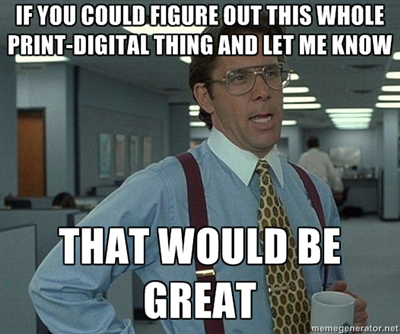We reviewed our NYT Print and Digital Literacy Projects in class today:
Initial, no-obligation brainstormed ideas. As you read through these, try keeping this WRD103 reflection (WQ 2013) in the back of your mind:
One unanticipated outcome of the project was learning about the extent to which reading is a social practice. We take for granted that writing is a social and civic activity, but many of us had not considered the effects of reading as a private, individual act made public, collective, and collaborative in some contexts, such as ours.
- Do you have a “deep-reading” brain? How do you know?
- Take a position: NYT print or digital? Use credible sources to support your claim(s)
- Choose an article and read it on three different platforms: print, digital, and mobile. Report on your reading experiences. This process will allow you to compare and contrast your experience with claims made about serendipity, annotation, and comprehension
- Rachel (11:20 section) is thinking of creating video interviews of students on campus regarding print and digital reading practices and preferences
- Brian (11:20 section) mentioned that he prefers digital textbooks over conventional print textbooks, which might put him in the minority. (A second source here claims that “Students Find E-Textbooks ‘Clumsy’ and Don’t Use Their Interactive Features.”) Can he use that preference to make a similar argument for reading the NYT in digital formats?
- “Half seriously, is there a booklet on “How to Read the Digital Times”? Can you create a booklet for Mr. Fejes?
- Louise Rosenblatt’s efferent and aesthetic reading practices: can you work with those concepts? Rosenblatt proposed these terms for reading in
 1978; have reading practices changed since then?
1978; have reading practices changed since then? - Can you work the serendipity or annotation angles?
- What is the current research-based empirical thinking regarding print and digital reading in terms of resolution, comprehension, attention, and memory?
- Do you feel like you might have more power and control over your reading with the NYT versus, say, a conventional textbook? If so, is some of that power and control taken away when you are limited to reading in specific formats? If you answered “yes” to both, solve that problem.
- Can you respond to the problem and project counter-intuitively, creatively, and without words?
- Are print readers missing out on NYT interactive and multimedia features? What does “reading” look like at this point early in the 21st century?
- What can we learn from your comparison, contrast, and analysis of some of the different NYT Skimmer versions?
- “How a Theater Major Reads the New York Times” report might be interesting, or “How a Business Major Reads the New York Times,” as we would get insights into your reading practices and contextual issues surrounding serendipity, annotation, and comprehension
- If none of these appeal to you, which seems unlikely, review the range of NYT digital platforms here, and develop your own ideas.

